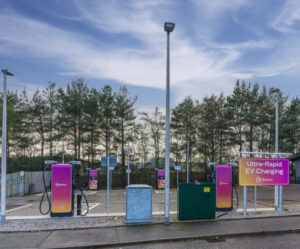Daisy Scholte, co-founder of Vegan Food Tour Utrecht, travel journalist and Impact Manager at the Better Places travel agency, expounds on the near-term future of tourism and the urgent need to rethink summer plans for the climate age.
Evening sunshine casts the inside of BROEI in a warm, natural light. A 100% plant-based restaurant situated on a stunning canal-side corner in central Utrecht, we’re here to refuel after a busy day exploring municipal sustainability projects that are rethinking how people use and navigate the Dutch city. Not that we feel too hungry.
For the past couple of hours, Environment Journal has been with Vegan Food Tour Utrecht, which, as the name suggests, showcases the finest food in town, sans animal produce. Co-founded by Patrick Boone and his partner Daisy Scholte, while the focus is very much local, the couple behind the enterprise also have a keen understanding of how global travel contributes to the climate crisis, and the challenges of trying to explore the world in a more sustainable way. Before the pandemic, they embarked on an enviable overland trip from the Netherlands to Iran, with Scholte working as a travel journalist at the time. Now Impact Manager at the Better Places travel agency, she starts by explaining the company’s approach.
‘We are a middle sized travel agency with a strong focus on sustainability. We’re also a social enterprise, which means our social impact is the number one mission and then comes profit,’ she says. ‘It’s always about small scale tourism. We don’t work with big hotel chains, for example. We work with eco lodges, locally run hotels, then it’s way easier to make sure all the money goes to the local entrepreneurs, not big industry. We are also very focused on activities that are about meeting local people with respect. So we don’t offer a visit to a tribe that has to put on a show, like a human zoo, as some call it.
‘We recognise the world is now in a climate crisis, there’s no better word for it, and have for many years understood reducing emissions is necessary. When we talk about travel, of course flying is the one of the least sustainable things you can do. In this industry, that’s a big elephant in the room because ‘we’ don’t want to discuss it. But at Better Places we admit this. If you go long haul, 90% of your overall emissions will be from the flight, only 10% from everything else, and there is such a focus on that 10%, with not many people wanting to look at the 90%,’ she continues.
In order to buck the trend and set a precedent for more responsible travel, Better Places was the first agency in the Netherlands to begin factoring offset costs into the price of trips. Quickly becoming aware that carbon credit projects were failing to deliver on promises, and concerned the process led to a false sense that any number of flights per year was acceptable if offsetting was employed, this policy has now stopped – at a time when most competitors are only just beginning to introduce compulsory offsetting.
‘We also factor in Scope 3 emissions to our carbon measurement, which a lot of other travel agencies do not. With tourism , that means flights. Many agents consider this to be separate to their package, they don’t technically sell the flight so it is not their responsibility for its emissions,’ Scholte explains. ‘Another thing we have started to do is introduce European destinations. We were focused on long haul as you can have a much bigger social impact in many destinations outside Europe. But with the shift towards more concern about the climate, this has changed and we have some very ambitious goals.
‘Now, we want 25% of our customers to travel by rail, when it used to be 100% by air. This percentage will increase each year to 2030,’ she continues. ‘And we’re no longer putting marketing budgets into long haul, so it’s these little things… Unfortunately, though, the aviation industry, from its beginnings, has been exempt from several taxes. This is still the case, so they don’t have to pay tax on fuels, or VAT on tickets. Which is crazy as every other comparable commercial industry does. It means the railways will never be able to compete on price if we don’t change this. And that’s a big discussion in Europe at the moment.’
Adding to the challenges, the logistical tools available for booking flights are far more comprehensive and user-friendly than the rail equivalents. For independent travellers, Skyscanner, for example, provides simple, single price quotes for any route no matter the number of airlines, territories and transfers involved. Once an option has been chosen, customers are redirected straight to airline or agent websites and are just a few clicks and card details away from completing their booking. By comparison, plotting an overland journey through different countries and regions by train is far more confusing, but this is may be on the verge of change.
‘I know that Frans Timmermans, the EU politician who introduced the European Green Deal, has instructed the EU rail industry to come up with a booking system involving all agencies. As we have for flying. Right now, for each country there can sometimes be more than one website you need to make a full route booking, and you need to be pretty knowledgeable to do this. So Timmermans has said they need to come up with a similar system to flights, which for years the industry has argued was not possible as it would be so complicated,’ says Sholte. ‘Now they’ve been told enough is enough, a deadline has been set and if there is nothing to show by that date the EU will design and build one which will have to be used.
‘Unfortunately, if we want to meet the climate goals we agreed in Paris, there’s only one solution – we have to fly less. That’s the only thing to do, because all the technologies we are working on now come in too late. Like electric flying, things like that – the range and capacity we need will not be here before 2050. If we don’t change by 2030, we have such a big problem. These technologies, like sustainable aviation fuel, they are not going to give us the solution now. They could in the long run, but the main thing that matters today is that we have to fly less,’ she continues.
Although that may sound easier said than done, significant developments in service provision, work-life balance, and trends post-pandemic do offer some hope. In Europe, several new affordable sleeper train are being introduced, which in turn are designed to link up with Eurostar terminals for onward travel to the UK. ‘Slow travel’ is on the rise, partly driven by the newfound freedoms of remote offices. Meanwhile, eco tourism is experiencing huge growth, with global market value expected to increase from $172.4billion in 2022, to $374.2billion by 2028.
Simply put, alternatives to flights are becoming more accessible, and consumer demand for overland trips is increasing. Even the price difference may not be so pronounced for much longer. According to the recent paper, A Realistic Path to Net-Zero Emissions for Commercial Aviation, some analysts expect to see a sharp increase in air fares within the next three years as the industry is forced to take serious action. The scale of investment in fuel research and development, not to mention fleet upgrades and ground operation efficiencies, means even with continued subsidies the cost of flights could be much closer to the cost of rail long before this decade ends.
‘We are now communicating differences for every destination on our website – this is the impact if you take a train, or a car, this is the impact for a flight,’ says Scholte. ‘We conducted a project calculating the true price of transport to a destination, and this was very interesting. You se0,e the impact from flights isn’t just CO2, there are many other things. Looking at it like this, there is a completely different story. For example, a return flight to Peru you can maybe find for €850. If you pay the true price, based on the total impact, it’s probably more like €1500.
‘Obviously a train to Peru would be complicated… but the calculations show that if we’re going to, say, Slovenia, the true price gap between a plane and train is tiny,’ she continues. ‘I would never say that you cannot fly anymore. Because I also know and I have seen with my own eyes during my travels what tourism can do, in a positive way for a destination, for nature – it can be the way to protect nature. And it offers so many jobs. One in 10 people worldwide are employed in tourism-related roles. So I see the importance. But I also believe that we don’t have to make a long haul holiday every year, but maybe once every four years. The other three years, just go closer to home.’
More on sustainability and travel:
$2.1trillion and fleet upgrades needed for net zero aviation by 2050
Image: Alex Person (Top) / Karl Callwood (Middle) / Daniel Abadia (Bottom)
















